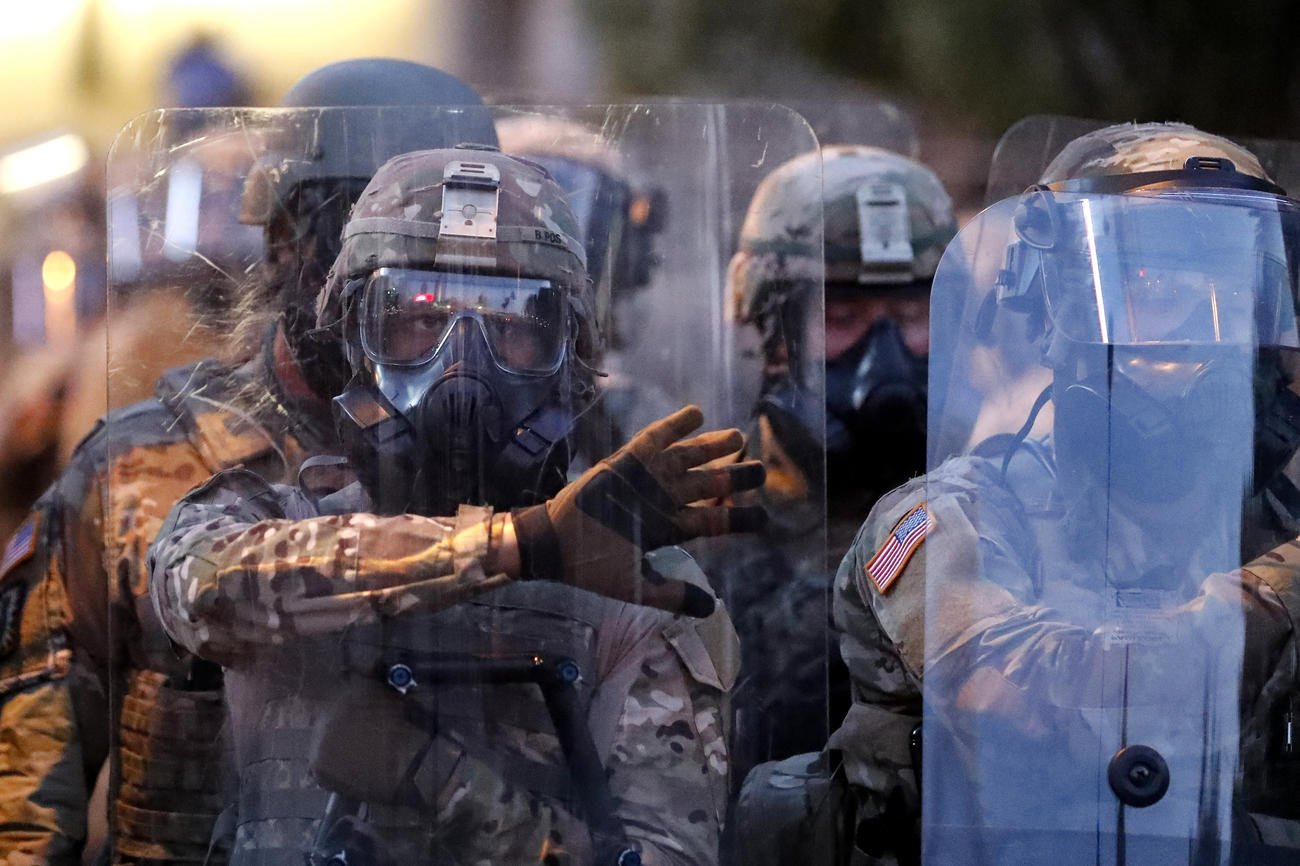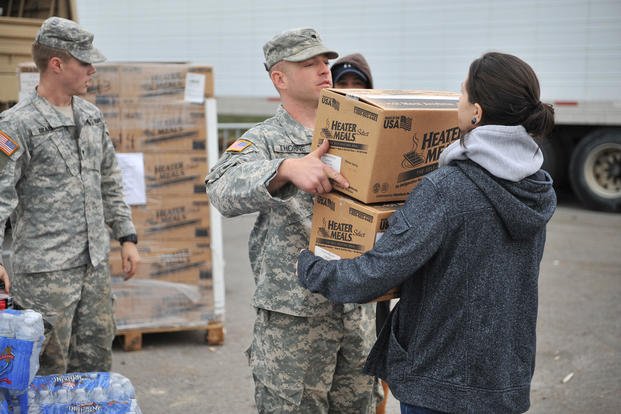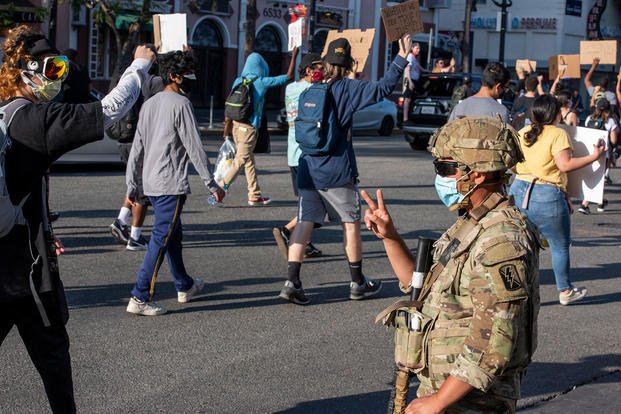
It seems like the National Guard has been everywhere in recent years: Battling wildfires this week in California, patrolling the New York City subway, cleaning up after hurricanes, administering Covid vaccines, filling in as school bus drivers, poll workers, nursing assistants, even substitute teachers during the pandemic.
During the wars in Iraq and Afghanistan, National Guard units deployed in both combat and support roles again and again. Of course, that’s come up recently when Republican vice-presidential candidate JD Vance—a Marine combat correspondent who deployed to Iraq—accused former National Guardsman Tim Walz of abandoning his unit. The Democratic vice-presidential candidate retired after 24 years from the Minnesota National Guard in 2005 to run for Congress two months before his unit received a mobilization order to Iraq.
That’s not the only time the Guard has come up in this election cycle. In stump speeches and policy videos, former President Trump has frequently mentioned deploying the National Guard over various issues: Curbing crime, clearing homeless encampments, quelling protests.
So what is the National Guard? What does it do? And what limits do state governors—and presidents—have on calling on the National Guard?
To dig into those questions, The War Horse spoke with three experts: Andrew Wiest, a historian and the co-director of the Center for the Study of the National Guard at the University of Southern Mississippi; Rachel VanLandingham, a retired Air Force judge advocate and a professor at Southwestern Law School; and Joseph Nunn, a lawyer in the liberty and national security program at the Brennan Center for Justice, a nonpartisan law and policy institute.
They helped us understand how the National Guard is different from the active duty military, and how it’s similar, from its earliest roots in our revolutionary history to the questions it faces today.
“It’s a uniquely American system,” Wiest says.
Q: Where did the National Guard come from?
A. Before the American Revolution, settlers in each of the 13 original colonies banded together for support and self-defense against various threats—the most prominent of which soon became the British Army. When the first shots rang out in Lexington, Massachusetts, in 1775, they were between British soldiers and the Massachusetts militia. Some of those militia soldiers were known as Minutemen, because—while they were not professional soldiers—they were an elite force that could quickly mobilize to fight against any danger that might emerge.
“It’s community defense,” Wiest says.
Q. Were they the ones who fought in the Revolutionary War?
A. Not the only ones. Eventually, the Continental Congress commissioned an army to wage war against the king. But local colonial militias continued fighting as well. And when the fledgling United States won the war, the constitutional framers opted to disband much of the Continental Army and keep the militias. The British were gone, but fear of a large, permanent army remained.
“Militaries stand in contrast to democracies,” VanLandingham says. “They can pose a threat by whomever controls the military.”
So the framers entrusted the security of the young nation to local citizens, who answered to their state governor and trained only part time, taking up the mantle of the soldier alongside their ordinary occupations of farmer or tradesman. When faced with great threats, the federal government could augment its small standing army with fighters whose first loyalty lay with their local communities—a structure that persists today in the National Guard.
Q. Who does the National Guard work for?
A. In its modern incarnation, each state’s National Guard is still usually under the command of its governor. During times of national need, National Guard troops can be “federalized,” or shifted to federal control, reporting to the president as their commander-in-chief.
A series of reforms starting at the turn of the 20th century standardized militias, which until then had varied greatly in terms of martial skill and experience, transforming them from “guys in their homespun clothes, carrying their own weapons,” as Wiest puts it, into modern fighting units.
While the nation has moved beyond its colonial commitment to maintain only a small standing army, today we still supplement our regular fighting force with Guard units. During the wars in Iraq and Afghanistan, more than 40% of the troops that deployed were Guard or reserve units. But the National Guard is also responsible for a whole host of non-combat missions stateside.
Q. So how are National Guard soldiers different from active duty soldiers?
A. Each of the military branches has an active side and a reserve component—soldiers, sailors, and airmen who train and deploy part time. In the Army and Air Force, National Guard units make up a large part of their reserves.
Since the end of the Vietnam war—and the draft—the Guard has been required to maintain the same training and readiness standards as the active duty and reserve military. Guardsmen (and other reservists) train part time while also holding down civilian jobs. Walz worked as a high school social studies teacher while serving in the National Guard.

Q. What does the National Guard do here at home?
A. A lot. When Guard units are under state control, a governor can essentially use them to plug any hole he or she sees fit—hence the myriad Guard mission sets during the pandemic.
“The Guard is this Swiss army knife,” Wiest says. “The big blade of war is just bigger and sharper than it used to be. [But] of course the other aspects, they didn’t go away.”
Governors can also “lend” troops to other states, if their governor requests them, usually under something called the Emergency Management Assistance Compact.
We often see this during large scale national disasters, when Guard units from across the country deploy to help fight a wildfire or clean up after a storm. And recently, the country’s southern border has been a particular hotspot of National Guard activity: Since 2021, 14 states have sent their National Guard units to the border at the request of Texas Gov. Greg Abbott.
Q. Does the president have the same power to tap the National Guard?
A. When the president federalizes National Guard troops, it’s often to go to war. But the president can also mobilize National Guard troops for domestic emergencies as well, such as Hurricane Katrina in 2005. And the last four administrations have sent National Guard units to the southern border, where they serve alongside troops deployed there under state control.
Q. Are there differences in how the National Guard acts, depending on who deploys it?
A. When National Guard units under federal control are operating alongside Guard units under state control—as on the southern border—things can get a little confusing. When the president deploys National Guard troops, they, like regular military units, are by and large forbidden from acting as law enforcement. It’s another hark back to our colonial legacy.
“There’s a longstanding discomfort within the American political landscape, going back to the founding fathers’ fear of a standing army, of having federal troops engaged in domestic law enforcement,” VanLandingham says. “That’s what the bloody British were doing.”
The principle was codified after the Civil War, when Southern lawmakers, frustrated by the U.S. Army’s deployment to the South during Reconstruction, pushed to pass the Posse Comitatus Act, which bars soldiers from enforcing domestic laws. The law’s passage ultimately helped usher in the Jim Crow era. But since then, experts say, the Posse Comitatus Act has served as an important bulwark for civil rights.

Q. What about when governors deploy them?
A. When National Guard units are under the control of their governor, they aren’t considered part of the armed services—so posse comitatus doesn’t apply. But in a complex mission, like the one on the border with Mexico, the distinction between working directly with law enforcement, and working indirectly with law enforcement, isn’t always clear.
“What constitutes law enforcement, what constitutes executing the law, is a fuzzier question than it really should be,” Nunn says.
Q. So, to be clear, the National Guard essentially has two bosses and very diverse missions?
A. Yep. And it gets more confusing: Sometimes National Guard units operate in a hybrid status, where they report to their governor, but their mission is determined by Congress and paid for by the federal government. That’s usually used for training or responding to natural disasters.
There can be tension among the Guard’s priorities. Increasing the Guard’s obligations on the homefront can cut into its readiness to deploy overseas, and being ready to work alongside law enforcement—or any other state mission—and being prepared to integrate into the active duty military are very different things.
“Dealing with political strife in your state is a very specific skill set. Driving around in a tank and fighting bad guys is another very specific skill set,” Wiest says. “The Guard is expected to have both.”
Q. Do governors always get a say if the president wants to deploy the National Guard?
A. Sometimes they do and sometimes they don’t. The federal government’s ability to mobilize the National Guard is codified in a number of different statutes, depending on what the Guard will be used for, among other things.
Q. When former President Trump talks about “sending in the National Guard” to deal with hot-button issues, how might it happen?
A. There are a few possibilities. Posse comitatus is important here, because when federal troops are acting under federal command, they usually can’t work as law enforcement. But a sympathetic governor could take cues from the White House and activate their own National Guard to address issues within their state borders—or perhaps loan their Guard to a different state that requests it.

Q. Are there other ways for the president to send in the Guard?
A. Yes. And the second possibility is very specific—but it’s already happened.
In some ways, it’s unique to Washington, D.C. Because D.C. does not have a governor, the D.C. National Guard always reports to the president. During Black Lives Matter protests in 2020, President Trump deployed the D.C. National Guard. But he also requested that various state governors deploy their Guards to Washington—despite the D.C. mayor’s objections—and 11 states agreed, flooding the tiny district with more than 4,000 Guardsmen.
“That’s the weird one,” Van Landingham says. “But it’s the weird one that turns out has huge ramifications.”
Remember that hybrid status we mentioned above? The Guard units in D.C. technically remained under state governor control—and thus could act in a law enforcement capacity. But they were executing a mission at the request of the federal government, and once in D.C., it was the federal government that effectively decided where they should go and what they should do.
Some legal scholars have raised questions about whether a president in the future could use this same hybrid status to send National Guard troops into states without the consent of their governors.
It’s a complex situation, and a little wonky. But that brings us to a third possibility, which is far less complicated: The Insurrection Act.
Q. What’s the Insurrection Act?
A. “The Insurrection Act is the 800-pound gorilla in the room,” Nunn says.
The act dates back to 1792. It grants the president essentially unchecked authority to use the military—including federalized National Guard troops—“whenever the president considers that unlawful obstructions, combinations, or assemblages, or rebellion against the authority of the United States make it impracticable to enforce the laws of the United States.”
The act has been used fairly regularly throughout American history, Nunn says. In fact, we are currently in the longest period in which it hasn’t been used—the last invocation of the Insurrection Act was 1992, when President George H.W. Bush sent active duty Marines and National Guardsmen into L.A. during the riots after the police beating of Rodney King.
Q. Wait, so a president can call on active duty military—not just the National Guard—to patrol American streets under the Insurrection Act?
A. That’s right. When a president invokes the Insurrection Act, they can send in any troops, including active duty military or federalized National Guard units. And when troops are mobilized under the Insurrection Act, posse comitatus does not apply: Although they are under federal command, they may act in a law enforcement capacity.
While the Insurrection Act has been used to safeguard civil liberties—including, famously, to ensure school desegregation in the South—it has no provisions for oversight or checks and balances: The president alone may decide when federal troops are needed to “enforce the laws of the United States,” and he or she can federalize National Guard units without their governor’s consent.
Nunn and other experts have called for the act to be reformed, arguing that the law hands the president too much power—that it undermines our historical legacy of supreme caution when it comes to using the military against its own citizens.
“If the 2024 election was between George Washington and Abraham Lincoln, I would still be here telling you that the Insurrection Act is a problem,” Nunn says.
“It is simply too much discretion for the executive to have in a free society ruled by law.”
This War Horse explainer was reported by Sonner Kehrt, edited by Mike Frankel, and fact-checked by Jess Rohan.
Editors Note: This article first appeared on The War Horse, an award-winning nonprofit news organization educating the public on military service. Subscribe to their newsletter.
© Copyright 2024 The War Horse. All rights reserved. This material may not be published, broadcast, rewritten or redistributed.
